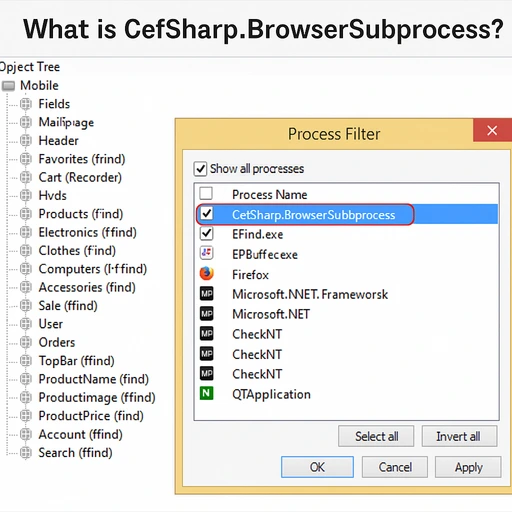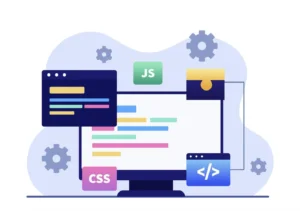CefSharp is a free and open-source tool that allows developers to embed a Chromium-powered browser inside .NET desktop applications (like WinForms or WPF). It is built on top of the Chromium Embedded Framework (CEF) and supports modern web technologies such as HTML5, CSS, and JavaScript.
The CefSharp.BrowserSubprocess is a background helper process used by CefSharp to handle tasks such as rendering web pages, running JavaScript, and isolating browser operations from the main application. This separation helps improve app performance and prevent crashes, making it essential for running embedded browser content safely and smoothly.
While it often runs in the background, this subprocess is usually safe, especially if it comes from a trusted software source. However, some users may experience issues like high CPU or RAM usage, which can be managed through task manager monitoring, software updates, disabling startup items, or uninstalling the parent app if not needed.

Users can identify the CefSharp process by opening the Task Manager, checking the file path, and verifying the associated software. If needed, it can be safely removed by uninstalling the app that uses it.
For developers, integrating CefSharp is simple via NuGet, allowing them to embed a browser using minimal C# code. However, proper security practices must be followed, such as using HTTPS and sanitizing user input to avoid vulnerabilities.
In the current tech landscape, CefSharp remains useful but is now competing with alternatives like Microsoft WebView2, which is lighter and more modern for Windows 10/11 apps.
In Short Way:
- CefSharp adds browser features to desktop apps using Chromium.
- BrowserSubprocess runs web content in the background safely.
- It is not malware if tied to a known app.
- High CPU issues can be fixed with some simple system checks.
- Developers can use it easily, but should consider security and newer options.
- WebView2 is a newer alternative but CefSharp still works well for many apps.
What is CefSharp BrowserSubprocess?
CefSharp is a free, open-source project. It lets software developers add web browser features to their apps by using Chromium – the same engine that powers Google Chrome. CefSharp is written in C# and works well with Windows Forms and WPF (Windows Presentation Foundation).
Why Developers Use It
- It’s easy to use with .NET apps
- It supports JavaScript and modern web content
- It’s based on Chromium, which is fast and secure
More Facts About CefSharp BrowserSubprocess
| Feature | Details |
|---|---|
| Language Support | C#, .NET |
| Built On | Chromium Embedded Framework (CEF) |
| Platforms | Windows Only |
| Used For | Embedding web browser in desktop applications |
| Developer Access | Open source (GitHub) |
Understanding the CefSharp BrowserSubprocess
The BrowserSubprocess is a part of CefSharp. It’s a helper process that handles web content loading separately from the main app. This makes sure the app doesn’t crash if a webpage freezes or fails.
What It Does
- Loads webpages inside the app
- Runs JavaScript securely
- Handles browser tabs if multiple are open
Why It’s Separate
Having a separate subprocess means better performance and safety. If the browser tab crashes, it won’t take the whole app down with it.
Why Does CefSharp BrowserSubprocess Run in the Background?
Even when you’re not actively browsing, the CefSharp BrowserSubprocess might still be working in the background. Here’s why:
Main Reasons
- Background pages or services are still open
- Notifications from a web app (like chat or email)
- Preloading websites or ads
- Idle processes that weren’t closed correctly
Is CefSharp BrowserSubprocess Safe?

Yes, in most cases. If it came from software you installed, it’s likely part of that software and is safe.
But…
If you didn’t install any app that uses CefSharp, or if it’s using too much CPU/memory, it’s worth checking.
Safety Tips
- Check the file location: It should be under
C:\Program Files\or related app folder - Use antivirus software to scan the file
- Right-click and check properties for the developer name
How to Identify CefSharp BrowserSubprocess in Task Manager
You might see one or more “CefSharp.BrowserSubprocess.exe” entries in Task Manager. Here’s how to spot it:
Steps
- Open Task Manager (Ctrl + Shift + Esc)
- Click on the “Details” tab
- Look for CefSharp.BrowserSubprocess.exe
- Right-click → “Open file location” to verify its origin
Tip
If the location is suspicious or unknown, investigate further.
Common Problems Caused by CefSharp BrowserSubprocess
Sometimes, this process can cause system issues.
List of Common Problems
- High CPU usage
- Memory leaks
- System lags or freezes
- Security concerns (in rare cases)
Step-by-Step: How to Fix High CPU or RAM Usage
Step 1: Identify the Problem
- Open Task Manager
- Monitor CPU and RAM use of CefSharp
Step 2: End the Task Temporarily
- Right-click the process → End task
Step 3: Disable Startup Programs
- Go to Startup tab → Disable unnecessary apps
Step 4: Clean the System
- Run Disk Cleanup
- Use trusted software to scan for junk files
Step 5: Update or Reinstall the App
- Outdated software may cause issues. Try updating the parent app
How to Remove CefSharp BrowserSubprocess (If Needed)
Only remove it if:
- You don’t need the app that uses it
- It’s causing problems and cannot be fixed
Steps to Uninstall
- Go to Control Panel → Programs → Uninstall a program
- Find the parent app using CefSharp (like a PDF viewer or chat app)
- Uninstall it
Note: Deleting the EXE file only may cause the app to break.
How to Check If CefSharp BrowserSubprocess is a Virus
| Step | What to Do | Why This Helps |
|---|---|---|
| Step 1 | Open Task Manager. On Windows 10, just right-click the taskbar and select Task Manager. | This lets you see what programs and background processes are running. |
| Step 2 | Click on the “Details” tab and then right-click any column name at the top. Choose “Select Columns.” | This allows you to customize what info you see for each running process. |
| Step 3 | From the list, check the box next to “Verify Signer” and click OK. | The “Verify Signer” column shows if the process is signed by a trusted software company. |
| Step 4 | Look through the list and find “CefSharp.BrowserSubprocess.exe.” | This is the process you want to examine to see if it’s safe or suspicious. |
| Step 5 | Check the “Verify Signer” value for CefSharp. If it says something like “Unable to verify” or doesn’t show a known publisher, be cautious. | Legitimate software is usually signed. If it’s not, it could be unsafe or a fake. |
| Step 6 | If you’re unsure, right-click the process → Open File Location. Scan the file with your antivirus software. | This gives you the file path and lets you check where it came from. Unknown folders are a red flag. |
Tips to Prevent CefSharp from Slowing Down Your PC
Simple Tips
- Keep your apps updated
- Avoid running too many apps at once
- Use lightweight alternatives if available
Advanced
- Use Task Scheduler to delay startup
- Disable unnecessary web features inside the app settings
Real Uses of CefSharp in Software

Many apps use CefSharp without you even noticing.
Examples
| Application Type | How CefSharp Is Used |
|---|---|
| Messaging Apps | Show chat with embedded web tools |
| PDF Readers | View web-based manuals or links |
| Finance Tools | Load stock charts from web |
| CRMs | Embedded dashboards |
| Educational Apps | Interactive lessons using HTML5 |
Common Myths and Misunderstandings
Myth 1: It’s a Virus
Truth: It’s not a virus if installed from a trusted app.
Myth 2: It Should Never Run
Truth: It’s normal for this process to run when an app is active.
Myth 3: You Can Just Delete It
Truth: Deleting it can break your app.
Developers’ Guide: How to Use CefSharp in Your App
If you’re a developer, adding CefSharp to your app is straightforward.
Steps to Add CefSharp
- Create a .NET app (WPF or WinForms)
- Use NuGet to install CefSharp packages
- Add a ChromiumWebBrowser control to your form
- Load your web page with
browser.Load("https://example.com")
Example Code (C#)
csharpCopyEditvar browser = new ChromiumWebBrowser("https://www.google.com");
this.Controls.Add(browser);
Security Tips When Using CefSharp in Your System
User Tips
- Don’t install unknown apps
- Use antivirus software
- Keep your system updated
Developer Tips
- Always use HTTPS in your web content
- Sanitize user input to avoid XSS
- Keep CefSharp version up to date
Expert Insight: Is CefSharp Still the Best Browser Engine for Apps?
What Experts Say
Some developers still prefer CefSharp for its strong Chromium support. But others now look into newer options like WebView2 from Microsoft.
Comparison In Easy
| Feature | CefSharp | WebView2 |
|---|---|---|
| Based On | Chromium | Chromium Edge |
| Microsoft Support | No | Yes |
| Lightweight | Medium | High |
| Integration | Easy with .NET | Easier with Win10/11 |
Final Thoughts
CefSharp BrowserSubprocess is not something to be scared of. It’s a normal helper tool used by many desktop apps. But knowing how it works helps you keep your system healthy.
Whether you’re a developer or a user, understanding CefSharp gives you better control over your apps and your computer’s performance.
FAQs
Q1: What is CefSharp BrowserSubprocess?
The CefSharp BrowserSubprocess is a background helper that works with the CefSharp framework to load and display web content in desktop apps. It allows embedded browsers inside apps to function smoothly without affecting the main program.
Q2: Why is CefSharp BrowserSubprocess running on my computer?
You’ll find CefSharp BrowserSubprocess running when an app using CefSharp is active. It’s needed to manage browser tasks such as rendering pages or executing JavaScript safely in the background.
Q3: Is CefSharp BrowserSubprocess a virus?
No, CefSharp BrowserSubprocess is not a virus. It’s a normal part of many safe applications. If you notice it and aren’t sure what app it belongs to, use antivirus software to verify its safety.
Q4: Can I delete CefSharp BrowserSubprocess?
It’s not a good idea to delete it manually. If you want to remove it, uninstall the software that uses it. Direct deletion can break the software that relies on it.
Q5: How do I check if CefSharp BrowserSubprocess is safe?
Open Task Manager, find CefSharp BrowserSubprocess, then right-click and choose “Open file location.” If it’s located in a known program folder like Program Files, and belongs to a trusted app, it’s likely safe.
Q6: Why is CefSharp BrowserSubprocess using high CPU or RAM?
This process may use more system resources if the embedded browser is running heavy scripts, complex pages, or isn’t optimized. Restarting the app or updating it often helps fix the issue.
Q7: Can CefSharp BrowserSubprocess slow down my computer?
Yes, especially if multiple processes run or the app it belongs to is using too much memory. Keeping only the needed browser windows open can help reduce the load.
Q8: How do I stop CefSharp BrowserSubprocess from starting automatically?
To stop it from launching automatically, disable the parent application in the Windows startup settings. Go to Task Manager → Startup tab → right-click the app → Disable.
Q9: Which apps commonly use CefSharp BrowserSubprocess?
Many desktop applications such as finance tools, chat clients, PDF readers, or dashboard systems use CefSharp to display web content without opening an external browser.
Q10: Can developers control how CefSharp BrowserSubprocess behaves?
Yes, developers can configure how the CefSharp BrowserSubprocess performs using specific settings in their app. They can limit scripts, disable tabs, or control memory use through code.
Q11: Is CefSharp BrowserSubprocess required for all CefSharp apps?
Yes, this subprocess is essential for any app using CefSharp. It runs the browser features separately to avoid crashes and improve stability.
Q12: How can I monitor CefSharp BrowserSubprocess activity?
You can use Task Manager to view its performance. Look for it under the “Processes” or “Details” tab to see how much CPU or memory it uses.
Q13: Can I limit the resources used by CefSharp BrowserSubprocess?
You can’t set direct limits unless you’re a developer. But users can reduce resource use by closing unused tabs in the app or ensuring the app is updated and optimized.
Q14: Does uninstalling CefSharp BrowserSubprocess affect other apps?
Only the specific app that uses it. If you uninstall or remove the app, the CefSharp BrowserSubprocess will no longer run. Other programs will remain unaffected.
Q15: Is there an alternative to CefSharp BrowserSubprocess?
Yes, Microsoft WebView2 is a modern replacement for developers. It’s lighter and integrates better with Windows 10 and 11 while still using Chromium under the hood.







